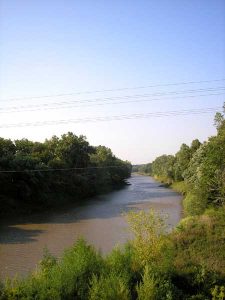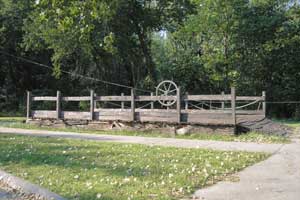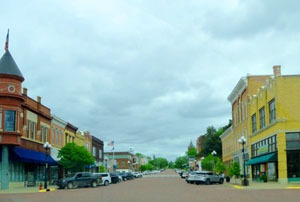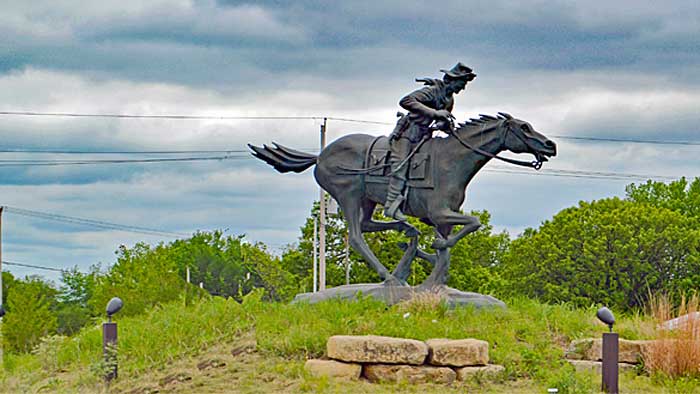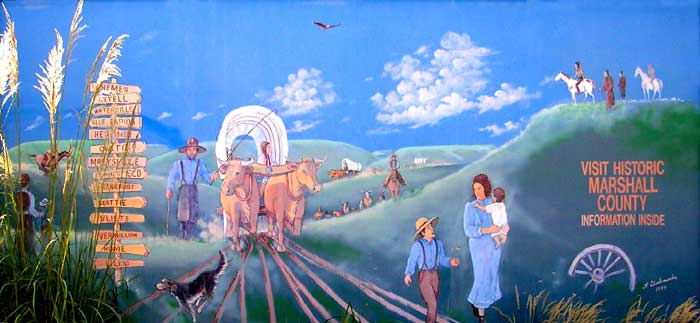
Marysville, Kansas Sign.
Marysville, the county seat of Marshall County and one of the oldest towns in Kansas, is beautifully located on the east bank of the Blue River, ten miles south of the Nebraska State Line. This historic town once stood on the Pony Express trails, St. Joe Road, the Overland Stage, the Military Road, and the Otoe-Missouria Trail. The old Pony Express Station still stands in downtown Marysville, KS.
In 1849, Francis. J. Marshall of Weston, Missouri, established a ferry on the Big Blue River, about nine miles below the present-day townsite of Marysville. This crossing was named “Independence Ford,” and it was from the trail that led from Independence, Missouri, the leading fur trade depot. In 1850, the Government opened the military road from Fort Leavenworth, crossing the river at what was afterward known as Palmetto or Marysville. Seeing many California emigrants use this route, Marshall moved his ferry to the site that would later become Marysville. He built a few log cabins there, opened a general store, and started a blacksmith shop. The chief commodity at his store was whiskey, sold at 18¢ per gallon. A post office was established in November 1854, with Marshall as the first postmaster. Today, this is the oldest civilian post office in the state and is continually operating. While a member of the first Kansas Legislature in 1855, Francis Marshall had a county laid off with the Big Blue River running through the center. He established the county seat at his ferry and named it Marysville in honor of his wife, Mary. The county is named for him.
When Marshall established his ferry at Marysville, he did not give up his place at the old Independence Crossing to run a ferry until 1853, the travel being divided between the two points for some years. At the ferry in Marysville, teams would gather by the hundreds, waiting their turn to cross, and some, becoming impatient, would ford the stream but at considerable risk. The capacity of his ferry was such that Marshall could only take three wagons at a trip, for which he charged $5 per wagon. Research shows that about 75,000 people traversed Marshall County and crossed the Big Blue River either at the lower crossing or at the crossing here from 1846 to 1856.
Today, Historic Trails Park features a full-sized replica of a rope ferry like the one Frank Marshall used in the 1850s to carry emigrants, soldiers, and stagecoach travelers across the Big Blue River. Eight trails crossed the river here: the Oregon, Pike’s Peak, and Mormon Trails, the St. Joe Road, the Overland stagecoach, military, and Pony Express routes, and the trail followed by Otoe Indians being sent to a reservation in Oklahoma. To get to the park, take U.S. 77 south out of Marysville, turn left immediately after the south overpass onto the levee road, and go 1.4 miles. Turn left into the park before the west overpass.
The Marysville Town Company originated in western Missouri, with John and James Doniphan and Francis Marshall being the prime movers. An act of the Territorial Legislature incorporated the company on August 27, 1855.
The next settler, James McCloskey, an Indian trader in company with other traders, settled a short distance south of Marysville in November 1855. The other members of the company soon after settled on the Vermillion River.
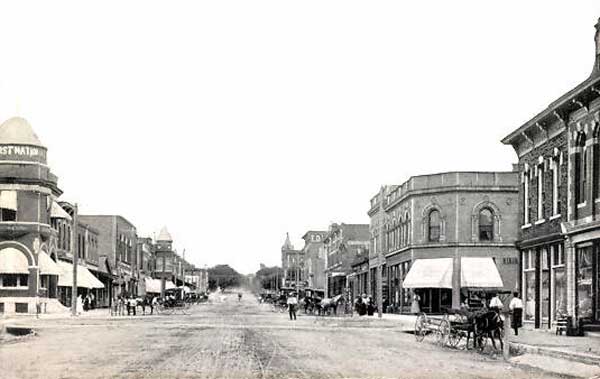
Vintage Marysville, Kansas.
In the meantime, a competing group of men was planning on settling at Marysville. In the spring of 1856, the Palmetto Town Company was organized in Atchison with 84 members, composed of Southern men with Southern sympathies. They were primarily young men who had come to Kansas Territory chiefly for political reasons and in the interests of the pro-slavery party. For various reasons, only 35 colony members left Atchison and arrived at Palmetto on July 8, 1856.
The colony filed upon and laid out a townsite of 320 acres adjacent to the Marysville townsite previously laid off and entered as a preemption claim by F.J. Marshall. The colony named the town in honor of the “Palmetto” State (South Carolina). The progress of Palmetto was slow, with none of the members seeming to care whether a town was made. The only improvement was the erection of a log cabin during the summer of 1856 by Dr. J. P. Miller.
Of the whole number of men composing the colony, only three or four remained in the state, and only two in the county — J.S. Magill and Robert Shibley.
Some early county officials used the town name of “Palmetto” for some time when dating their official proceedings. In the early maps of Kansas, the name Palmetto appeared, but Marysville was left out, although Marysville was the name of the post office and the established seat of justice for Marshall County.
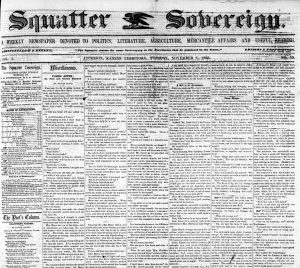 The following notice was published in the Squatter Sovereign of Atchison on March 25, 1856:
The following notice was published in the Squatter Sovereign of Atchison on March 25, 1856:
GRAND SPECULATION MARYSVILLE, KANSAS TERRITORY
I hold in my hand an obligation upon the Marysville Town Company, obligating the company to donate to the first person who will put up a steam sawmill in said town. Seven shares in the town are worth $200 each. Setting up the mill in the town will make them worth $250 each, which, when combined with a donation of $1,750, will nearly cover the cost of the mill. Marysville is in the best location in Kansas for a steam sawmill. It is located immediately on the Big Blue River, where the timber can be rafted to the mill and the lumber rafted below to supply the great Kansas River Valley. So you bring on your mill, set it to running, and I will give you the stock.
(Signed) “F. J. Marshall.”
The above liberal inducement was accepted by Messrs. Shibley & Quarles, who erected a steam sawmill in 1857 and operated it until 1861, when it was destroyed.
Among the first business enterprises and professions established in Marysville were those of Dr. John P. Miller, who also built the first house on the Palmetto townsite, where he located his practice in surgery. He remained in the practice of his profession until 1862, when he died. J. S. Magill was the first to represent the legal profession and was a member of the Palmetto colony.
In 1857-58, these two little antagonistic towns had a pretty rough class of citizens. Being outside civilization generally, the pop of the revolver and the clank of pure steel were familiar sounds, and in the absence of civil tribunals, anarchy reigned supreme. Marshall, bringing diplomacy to bear, soon succeeded in making Marysville the leading trading point, and in a few years, Palmetto would be forgotten.
The Palmetto Kansan, the first newspaper printed in the county, was established at Marysville on December 18, 1857. The paper was a Democratic Pro-slavery organ. Mr. Clardy continued the publication for seven months when the paper was suspended. In 1858, Mr. Childers tried to resuscitate it under the name Marysville Democrat, but the effort was short-lived. The Democrat Platform was first issued at Marysville in early 1859, and it continued until the Civil War broke out in 1861. Several newspapers followed over the years.
The first hotel built for public accommodation was opened in 1859 by A. G. Barrett. Later, it would change names and be called the “Tremont House.” That same year, Ballard & Morrall, of the town company, opened a drug store.
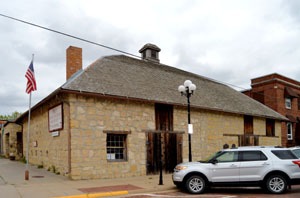
Pony Express Station Museum in Marysville, Kansas, by Kathy Alexander.
Also built was a stone barn by Joseph Cottrell, used as a home station for the Pony Express and Cottrell’s blacksmith shop. It was leased to the Pony Express in 1860. Between April 1860 and October 1861, riders traveled day and night through all conditions to carry letters from St. Joseph, Missouri, to Sacramento, California, and back. This usually took ten days, with riders changing horses every 12 to 15 miles. Marysville was the first “home station” west of St. Joseph (a station where riders and horses were changed).
The stone barn was used to stable the ponies and was where Cottrell kept his blacksmith shop. The riders likely slept at the nearby Barrett Hotel, where the Ar-Ex Drug Store is today.
The barn, listed on the National Register of Historic Places, is now a museum that consists of the original stable, the oldest building in Marshall County, and an annex added in 1991, which matches its architectural style. Its exhibits include those of the Pony Express and other trails and railroads, emphasizing Marysville’s broader historic importance as a transportation hub.
Marysville was incorporated as a city by an Act of the Territorial Legislature in February 1861. The same year, a school district was legally organized, and a small-frame school building was erected.
On November 30, 1863, citizens of Marysville and its vicinity held a preliminary meeting at the courthouse to organize a bridge company to build a bridge across the Big Blue River. The bridge was of the Howe Truss patent and was completed in November 1864. This bridge served its purpose until the spring of 1882, when an iron structure in Marysville Township replaced it.
One of the primary early industries was the Excelsior Roller Mills, built by Perry Hutchinson in 1864. Established on the east side of the Big Blue River, the first floor was occupied by the sawmill, while the rest of the mill was dedicated to custom work and flour, with a capacity of 100 barrels per day. This mill was run by water power furnished by the Big Blue River. It was later enlarged, giving it the capacity of 250 barrels of flour every 24 hours.
By 1866, the town had outgrown the small frame school building, and a new building of magnesia limestone was constructed for $8,000. The main building was 35×50 feet, with two additional wings and four large rooms.
Brick manufacturing began in 1869-70 by Thomas Cooper, who established a brickyard with a capacity of 300,000 per season in the southern part of the city. In the spring of 1882, he opened a yard on the south bank of Spring Creek, and during the season, he manufactured 6,000 bricks per day.
Schmidt & Koeste established the Exchange Bank at Marysville in March 1870. G.D. Swearingen opened the Sherman House in 1870 in a 16×24-foot frame building. Later, it would be significantly enlarged. That same year, the first train came into Marshall County over the St. Joseph & Western Railroad, and the next year, it was extended to Marysville.
In the earlier years of the settlement of Marysville, the population was in some measure of a transitory nature, and church organizations did not thrive to any great extent. However, when services were held, the attendance was good. Religious services were held in a saloon in Marysville in the summer of 1857. Later, services were held in Ballard & Morrall’s drug store and the Barrett House. A formal organization of the Methodist Church was made in 1866, with meetings held in different parts of the town until April 1879, when a 30×50-foot building was erected. Other church organizations followed, including the Episcopal, Presbyterian, German Evangelical, and Catholic.
The Marshall County Bank was incorporated under the State’s laws on October 8, 1880, with a cash capital of $50,000.
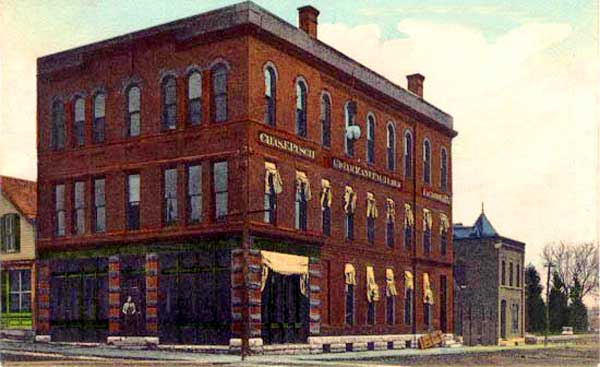
Cigar Factory in Marysville, Kansas.
Cigars were extensively manufactured in Marshall County, where there were four factories, three of which were located in Marysville. The oldest and most significant was the factory of Charles F. Pusch. In 1879, the factory of Charles E. Bendel was established. The firm of Bendel & Weidermeyer opened the third factory in May 1882. Other industries in Marysville included an iron foundry and a brewery.
In 1890, Marysville had progressed so far in advancing her educational interests that erecting another building was necessary. The new structure was erected on the same block, close to the other. It was a brick structure, 40×70 feet, trimmed with white limestone, and cost $10,000.
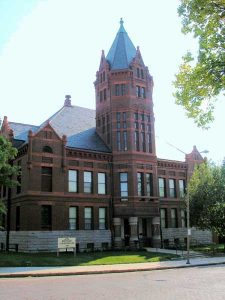
This historic 1891 Marshall County Courthouse is now a museum in Marysville, Kansas, by Kathy Alexander.
In 1891, Marysville spent $40,000 to build a beautiful red brick courthouse, which it donated to the county. This building served as Marshall County’s courthouse for nearly 90 years until a new courthouse was built next door in the 1970s. The old building, listed on the National Register of Historic Places today, now serves as a museum operated by the Marshall County Historical Society. It stands at 1207 Broadway.
In 1910, Marysville sat at the junction of the Union Pacific and the St. Joseph & Grand Island railroads. Historically and commercially, it is one of the most important towns in northeastern Kansas. It had paved streets, city waterworks, electric lights, a sewer system, an efficient fire department, three weekly newspapers (the Courier, the Advocate-Democrat, and the News), seven cigar factories, a broom factory, a flour mill, brick and tile works, planing mill, grain elevators, banking facilities, all denominations of churches, and good graded and high schools. The population in 1910 was 2,260.
By 1917, the town boasted a telephone system, several hotels, restaurants, an artificial ice plant, and all retail and service businesses.
Marysville’s population peaked in 1960 at 4143. As of the 2020 census, the population of the city was 3,447.
©Kathy Alexander/Legends of Kansas, updated August 2025.
More Information:
Visit Marysville
Marshall County Visitors Center
101 N. 10th St.
Hwy 77 & 36 Junction
Marysville, KS 66508
785-619-6050
Also See:
Sources:
Blackmar, Frank W.; Kansas: A Cyclopedia of State History, Vol I; Standard Publishing Company, Chicago, IL 1912.
Cutler, William G; History of Kansas; A. T. Andreas, Chicago, IL, 1883
Forter, Emma; History of Marshall County, Kansas: Its People, Industries, and Institutions, F. Bowen, 1917
Marshall County
Wikipedia

